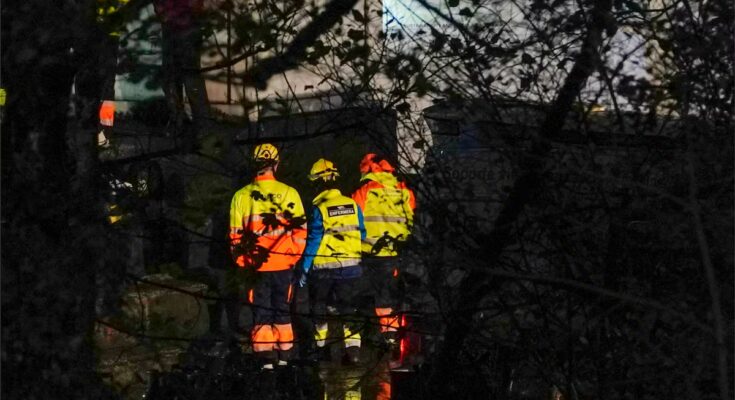By mid-afternoon on Friday, the village of Vega de Rengos fell silent. The noise of the ambulances broke the calm of the valley and the news of the collapse spread from cell phone to cell phone. “Here things are known in a few minutes,” said José Manuel Rodríguez, a resident of the municipality. In a nearby bar, several residents followed the official updates with the concern of those who know the miners’ work well.
Concern was mixed with the bitter familiarity that this area of southwestern Asturias has come to recognise. It wasn’t the first time the area had held its breath waiting for news from inside a mine. “The waiting is the worst,” José said. “You know every minute counts and there’s nothing you can do.”
Confirmation of the tragedy arrived shortly before eight in the afternoon. At 7.45pm, rescue teams had access to the body of the first miner, Óscar Díaz, who was now dead. The device then focused all its efforts on the second worker, Anilson Soares. The teams located him shortly afterwards, but freeing him was extremely complex because the collapse kept him buried in a still unstable area. His body could be recovered after 11.30pm. The tragedy hit his family hard, who had already lost another member in a mining accident. His younger brother, Adolfo, died in 2007 in a landslide in Pozo Calderón, Villablino.
The operation also demonstrated the importance of the Mining Rescue Brigade, an essential body in underground rescues. The members of the Pozo Fondón brigade were immediately mobilized in Vega de Rengos, despite having gone through one of the most tense weeks in their recent history, since 19 of the 21 members presented their resignations as volunteers after organizational changes that they consider unjustified. “However, when they were asked, their response was impeccable,” says Jose Luis Alperi, Secretary General of SOMA-FITAG-UGT. “The Brigade does not only exist when you want to applaud it, but it always exists”.
Although mining is no longer the economic engine it was in the 20th century, its impact remains profound in Cangas del Narcea. In the municipality, as in Degaña or Laciana, almost every family has someone who worked there. The reopening of Vega de Rengos has restored employment in an area affected by depopulation, but has also reactivated old fears. “Mining has transformed from a very manual activity into a much more mechanized activity and, with this transformation, there is an important change in the risk map,” explains Jose Luis Alperi.
Industry veterans insist that mining always carries a risk that cannot be completely eliminated. “No miner ignores the risks inherent in the mine environment; gases, ventilation and uncontrolled ground movement are perennial risks and very difficult to control,” he adds.
Although the European Union has ended public support for thermal coal mining to generate electricity, mining of other types of coal can continue when it meets specific industrial uses and complies with current regulations. Anthracite from Vega de Rengos, for example, is intended for steel and metallurgical processes, depending on its economic viability and compliance with regional and national safety requirements.
The exploitation of TYC Narcea was provisionally suspended in April 2025, after the Cerredo accident, in which five miners died. The Principality then ordered a complete review of the procedures and permits. After several months of checks, the regional administration authorized the resumption of activity in June, ensuring that everything was in order.
The first hypotheses point to a strictly geological origin. The mayor of Cangas del Narcea, José Luis Fontaniella, explained that the technicians speak of a collapse “that could not be predicted or calculated”, a sudden subsidence of the ground caused by the “breakage” of a rock whose breakage, he underlines, was impossible to detect. The suddenness of the collapse would have surprised the two workers in one of the most delicate areas of exploitation.
The memory of Cerredo’s accident was present in all conversations on Friday. Many talked about it as soon as they heard that there had been a collapse. The inspections following that incident tightened controls, but also left a trace of mistrust that has not entirely dissipated. “It was a hard blow,” another worker recalled.
The statement from the Workers’ Commissions also insists on differentiating the Vega de Rengos accident from the one that occurred in Cerredo last March. “The circumstances are not comparable,” they noted, recalling that the collapsed area had been examined the day before by the mining actuary. The union called for a “full and rigorous” investigation that will clarify the causes and strengthen safety protocols.
Alipio Díaz, a pre-retired miner and member of the Cangas del Narcea Mining Memory Association, describes the violence of the collapse. “Sometimes the mine warns. That is, you notice small noises or movements that give you space to react. But this time it fell all at once, without giving you time to do anything,” he explains.
Díaz also agrees with the unrest that is dragging on in the region. “We felt abandoned, even when there was more mining activity,” he laments and underlines an idea that many veterans repeat: “Safety comes first, but even this does not guarantee that there will be no accidents. There is always something in the mine that cannot be completely controlled.”
Friday night was long in Cangas del Narcea. The Municipality followed the rescue efforts in silence, waiting for every warning and every movement of the rescue teams. The collapse reminded everyone that the mine, however small, continues to impact the life of an entire territory.



